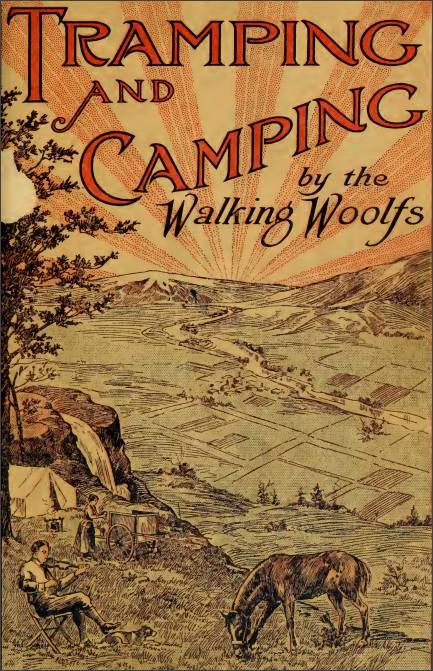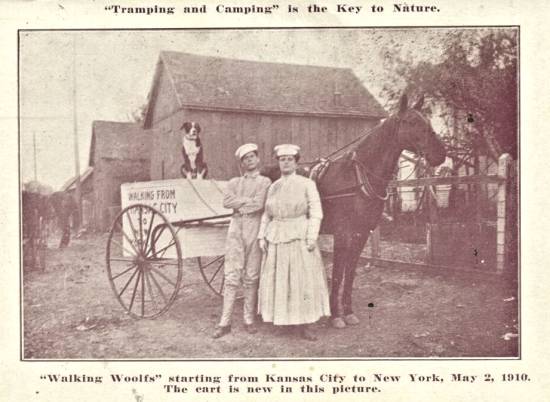Kansas Adventurers: Tramping and Camping with the Walking Woolfs
by randy rasa of www.kansascyclist.com
I stumbled across a very interesting and charming old book, Tramping and Camping by the Walking Woolfs, written by Dwight and Stella Woolf of Kansas City, Kansas in the early part of the 20th century. It is an account of their “journey to health”, accomplished by simply walking long distances.

The book’s introduction explains it pretty well:
The unique experience of Mr. and Mrs. Dwight H. Woolf, the champion Long Distance Walkers, has awakened general interest throughout the United States.In 1909, Mr. Woolf’s doctor informed him that he would have to get out in the open and stay there, or he would die. He weighed only 107 pounds, including clothes, and was growing weaker daily. Yet he hesitated about giving up his business as a music publisher — his life work; and it seemed a little short of madness to forego all the luxuries — the so-called “comforts” — of civilization.But Mrs. Woolf, who was a brave, sensible woman, thoroughly devoted to her husband’s interests, agreed with the physician and suggested a walk to the Ozark Mountains.That was the beginning of a most remarkable series of trips through Missouri, Kansas, Texas, Mississippi, Alabama, Georgia, and up through the north Atlantic States to New York and Boston, then home to Kansas City — in the aggregate, a journey of about 10,300 miles.Yet, wherever the couple went there was really but one destination—health. Mr. Woolf gained strength and, not long after starting, was able to make twenty-five or thirty miles in a day. Clad in neat khaki uniforms, he and his wife– now the leading woman pedestrian of the world — marched from city to city, accompanied by Dolly and Don, their faithful horse and dog.The group was often surrounded by cheering crowds, or met by newspaper reporters and escorted with honor by delegations of police into the presence of mayors and other officials, who received the travelers cordially.But the “Walking Woolfs” gained something far more valuable than honor or fame; and their advice to others who have suffered from the effects of sedentary work is: “When you get into a rut walk out of it.”He who draws close to nature is rewarded in many ways, not the least of which is perfect health. The object of this book is to preach the doctrine of exercise and fresh air.
It’s fascinating to see how — even in the early days of the automobile and the heyday of the passenger train — walking for transportation was seen as “odd”, and yet something to be celebrated as well.
The Woolfs camped along the way, setting up a tent in the woods or in the yard or field of a friendly farmer. They encountered everyday kindnesses in the country they passed through, though not all were welcoming: “A woman who saw us and supposed that we were gipsies, pulled her children into the house for fear that we might steal them.”
The book begins with “Hints for Health”, and these are some good, pithy tips, as valid today as they were a hundred year ago:
Health comes first.
Get up early.
Go to bed early.
Get plenty of fresh air
Drink plenty of water.
Exercise daily in the open air.
Never be in a hurry at meal time.
It is better not to eat enough than too much.
Two meals a day are enough for persons employed at office work.
Don’t jeopardize your health to make money.
Wealthy men would give their riches for health.
Health is easy to lose and hard to gain.
There is a bright side to life if you look for it.
If you can’t think of something pleasant to talk about, be a good listener.
Don’t worry — get back to nature.
Don’t sleep with a closed window.
Open the window at the top.
Best Remedies — Fresh Air, Sunshine, Exercise, Water, Nature.
Remember — That the largest amount of your ailments come from the lack of exercise and fresh air.
What’s all this got to do with bicycling? Perhaps not much, but bicycle touring is just another form of the sort of tramping that the Woolfs enjoyed. It’s celebrated by some, met with derision or suspicion by others, and is simply incomprehensible to too many. It depends on the generosity and hospitality of the communities we pass through. And, like walking, it’s a marvelous way to see, and really experience, the countryside.
You can read the book online at archive.org, where it’s also available as a PDF download or an ebook for Kindle or Nook.
The Hutchinson News reported on one of their trips in 1912:
Tho Walking Woolfs Have Finally Reached San Diego. Mr. and Mrs. Dwight Woolf, who style themselves the “Walking Woolfs’, who passed through Hutchinson this summer, walking from Kansas City to tho Pacific coast, have finally reached their destination, San Diego, Calif. Speaking of their arrival there, the San Diego Tribune says “Walking down Fifth street about 10 o’clock this morning a man and n woman, both brown as berries and dressed in khaki on which the alkali dust clung in spots, came, head up and chest out, one on each side of a horse that was pulling a wagon plastered with cards and inscriptions of all sorts. The dog came trotting behind. They were Mr. and Mrs. Woolf, of Kansas City, Molly the horse who has tramped twelve thousand miles, and Don, the dog. They are known as the “Walking Woolfs”. When asked about his trip and the object of it, Mr. Woolf said it was mainly for health. “We left Kansas City May of this year,” Sir Woolf said. “We Walked across the Utah desert two hundred miles with great difficulty. When in the middle of the desert we smashed a wheel, which could not be remedied, and there we stuck for two weeks. We were beginning to get worried about the water and provisions when members of the Utah Construction company rescued us. “When we leave San Diego we go to Los Angeles, San Francisco, Seattle, and then back to Kansas City, via Yellowstone Park.”
This article tells a little bit more of their story: “Finally, after having walked nearly 20,000 miles, Dwight, Stella, Dolly, and Don came home for good in November of 1915. From their daily journal, they published a 250-page book entitled Tramping and Camping by the Walking Woolfs. They also published a 34-card set of postcards from the numerous photos taken during their six years of walking across America. It isn’t known what happened to the Woolfs: What did they do throughout the rest of their lives? How long did they live? All of this is a mystery. But one thing is sure–they must have had some great stories to tell.”
Here’s one of their postcards:

“Tramping and Camping” is the key to nature.
